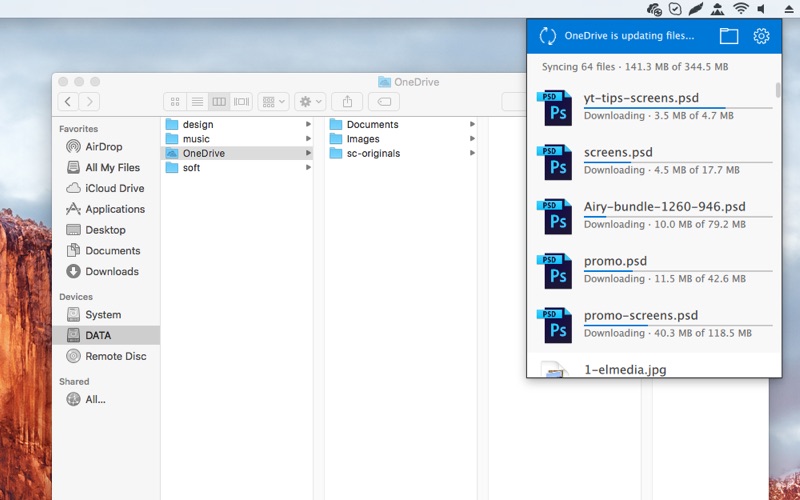Onedrive App Setup For Mac
OneDrive is a cloud storage service from Microsoft that allows you to store all your important files securely in one place and then access them virtually anywhere.It works just like a traditional hard drive, but it's on the internet, and you get access to additional features. For example, thanks to its cross-device and cross-platform design, you can create a file on your computer, and pick up where you left off on your laptop, tablet, or phone without having to save a copy on a USB drive or email the file to yourself. Also, makes it easy to share content with other people, and collaborate in real-time using its integration.users get even more benefits. When your PC is connected using a Microsoft account, you're not only able to store files in the cloud, but you can sync and roam Windows settings across all your devices, and store recovery keys and other data.
Files On-Demand is another great feature that lets you access files without having to download them first saving a lot of local storage. And because data is stored in the cloud, it also works as a data recovery mechanism if your device breaks or gets stolen.
With OneDrive installed on your Mac, you can synchronize files between the two with ease, allowing you to open images, documents, and more on either device without any additional effort on your part. That’s one way to download and install OneDrive, but you can also download it via your Mac App Store. Open up your Mac App Store. Type “OneDrive” in the search field at the upper right section of the window. Once you find it, click on “Install” below the OneDrive icon.
Here we'll go through the process to create an account, set up the sync client on your PC, perform everyday tasks, and customize common settings.How to create a OneDrive accountYou're required to use a Microsoft Account to use OneDrive.
Before you begin
- Update your iPhone, iPad, or iPod touch to the latest iOS or iPadOS, and your Mac to the latest macOS.
- Set up iCloud on all of your devices.
- Make sure that you’re signed in to iCloud with the same Apple ID on all of your devices.
- If you have a Windows PC, update to Windows 7 or later and download iCloud for Windows.
If you have a device that can't update to the latest iOS or macOS, see the minimum system requirements to use iCloud Drive. Logic studio 8 full pack serial.
Get started
Set up iCloud Drive everywhere that you want to access and edit your files.
How to install and use Gmail Password Cracker: Download the tool from the official site. Run the application; Accept all terms and conditions. Enter the address of the ID you wish to hack. The password hacker can then be exported as a text file. Free gmail password cracker for mac. It works through the ported machine engine to crack into Gmail accounts without informing to the actual account holder. Gmail Password Hacker Features. Fast response time. IP and Mac address hidden at all times. Gmail Password Cracker Free for malware. Safe hacking for secure passwords. Hacks the unlimited number of Gmail account. Gmail Password Cracker & Hacker Free. Cracks4download.com – Gmail Password Hack Tool 100% Hack in 2 Minutes. In this modern world, sometimes hacking is crucial for us. In different instances, we may need to hack any password to get fast access to our objectives. If anyone wants to hack Gmail password, then, fortunately, you are at the right site.
On your iPhone, iPad, and iPod touch
- Go to Settings > [your name].
- Tap iCloud.
- Turn on iCloud Drive.
You can find your iCloud Drive files in the Files app.
If you're using iOS 10 or iOS 9, tap Settings > iCloud > iCloud Drive. Turn on iCloud Drive, and tap Show on Home Screen. Then you'll find your files in the iCloud Drive app.
On your Mac
- Go to Apple menu > System Preferences, then click Apple ID. If you’re using macOS Mojave or earlier, you don’t need to click Apple ID.
- Select iCloud.
- Sign in with your Apple ID, if you need to.
- Select iCloud Drive.
If you want to add the files from your Mac Desktop and Documents folder to iCloud Drive, update your Mac to macOS Sierra or later then turn on Desktop and Documents. On your Mac, you can find the files on your Desktop and in your Documents folder in Finder under iCloud. If you add a second Mac Desktop, the files from your second Mac won't automatically merge with the files on your first Mac. Go to your Desktop and Documents folders in iCloud Drive, then look for a folder with the same name as your second Mac.
On iCloud.com
- Sign in to iCloud.com.
- Select Pages, Numbers, or Keynote.
- Click Upgrade to iCloud Drive, if you are asked to upgrade.
On your Windows PC

After you set up iCloud Drive on your iPhone, iPad, iPod touch, or Mac, you can set it up on your Windows PC.
- Go to Start, open Apps or Programs, and open iCloud for Windows.
- Enter your Apple ID to sign in to iCloud.
- Select iCloud Drive, then click Apply.
What's next
After you set up iCloud Drive, any documents that you've already stored in iCloud are automatically moved to iCloud Drive. Your iPhone, iPad, and iPod touch keep your files in the Files app in addition to the Pages, Numbers, and Keynote apps. If you don't see your files in these apps, they might be on a device that doesn't have iCloud Drive turned on.
Learn more about using iCloud Drive.
